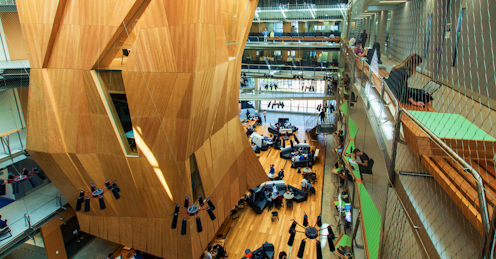Australian women are more educated than men, but gender divides remain at work
- Written by Michael Coelli, Associate professor, The University of Melbourne

The Bureau of Statistics has just released a new set of data[1] from the 2021 census. The first set – released in June 2022 – covered topics including age, sex, religion, unpaid work and country of birth.
The second set, released on Wednesday, provides insights into the kinds of jobs Australians have (and if they have a job), how Australians travel to work (and if they still do), and their educational qualifications.
There is plenty to digest. I’ll focus on a couple of interesting outcomes:
differences in the types of jobs held by men and women,
differences in the educational qualifications of men and women.
The most male and female jobs
Men accounted for around 99% of Australia’s bricklayers and stonemasons, plumbers, sheetmetal trades workers, carpenters and joiners, roof tilers and concreters in 2021.
Women accounted for 97% or more of Australia’s midwives, early childhood teachers, dental assistants, personal assistants and beauty therapists.
But the segregation is becoming weaker over time.
One common measure is the Duncan index of dissimilarity[2]. It records the proportion of female workers who would have to change their occupations in order for female representation to be even across all occupations.
I have calculated this measure using census data from 1966 up to 2021, updating work I completed with Jeff Borland up to 2011.
Read more: The 2021 Australian census in 8 charts[3]
The encouraging news is that segregation is declining, and declined further in the past two censuses. Having said that, the occupational differences are still large.
Back in 1966, nearly two-thirds of women would have had to change occupations in order to be spread across occupations as men are. By 2021, the proportion had fallen to close to half.
As women joined the workforce in greater numbers from 1966 to 2021, the proportion of women in most broad occupational groups grew.
But the growth has differed by the type of job. The proportion of women in managerial occupations grew from around 18% in 1966 to nearly 40% in 2021.
The proportion in professional occupations grew from 35 to 56%. In technical and trades occupations, it only grew from 8 to 17%.
Read more: Yet again, the census shows women are doing more housework. Now is the time to invest in interventions[4]
Some recent increases (from 2006 to 2021) in the proportion of women in specific manager and professional occupations stand out. These include vets (from 46% to 66%), dentists (31% to 47%), barristers (22% to 38%), school principals (50% to 65%) and internal medical specialists (32% to 47%).
But some professional occupations have gone the other way. The proportion of women working as financial dealers fell from 41% to 31%. The proportion of women working as physiotherapists fell from 71% to 64%.
Highly educated young women
The increasing shares of women in professional occupations is matched by increasing education attainment.
The proportion of females aged in their 30s with a bachelor’s degree or higher qualification was one half in 2021. This is strikingly higher than both the proportion of males in that age group with a bachelor’s degree or higher (about 38%) and the proportion of older females with degrees, which was 11% for females over 75.
This difference indicates how rapidly female university education has grown.
Female university graduates now outnumber male university graduates in every age group below 70.
But the proportion of males with certificates and diplomas is higher than the proportion of females across all age groups from 20 up.
This is reflected in the still-low proportion of females in technical and trades occupations.
More to explore
Gender differences in jobs and education are just two of the many ways the census can help us understand Australia.
Every five years it presents researchers and the curious with a lot to explore, including changes over time.
A few years back the five-yearly census was facing the axe[5]. It would be great if it continued to provide these insights for decades to come.
Read more: The gender qualification gap: women 'over-invest' in workplace capabilities[6]
References
- ^ new set of data (www.abs.gov.au)
- ^ Duncan index of dissimilarity (en.wikipedia.org)
- ^ The 2021 Australian census in 8 charts (theconversation.com)
- ^ Yet again, the census shows women are doing more housework. Now is the time to invest in interventions (theconversation.com)
- ^ facing the axe (www.smh.com.au)
- ^ The gender qualification gap: women 'over-invest' in workplace capabilities (theconversation.com)
Authors: Michael Coelli, Associate professor, The University of Melbourne







